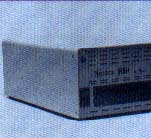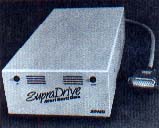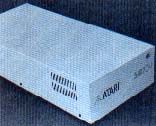THREE HARD DISK DRIVES
Massive storage without massive prices
by Howard Root
A hard disk drive is a bit like an electric can opener. Basically, either it works or it doesn't. Some can openers are slightly faster than others, but unless you run a restaurant and open hundreds of cans a day, the speed difference doesn't matter very much. You can mount can openers in different ways--on a counter, on a wall or under a cabinet. Some can openers are more convenient to use than others. And some can openers are built better and will last longer than others.
Likewise, some hard disk drives are faster than others (though unless you are doing an extraordinary number of disk accesses, the differences are negligible). They come in different shapes, sizes and levels of convenience. And the quality can vary, too--unfortunately, this is not something that may be readily apparent when you buy a hard disk.
Here I review three hard disk drives for the Atari ST: the Astra System HD+, the SupraDrive, and the Atari HD204. In many ways they are different, and your personal preferences may lead you to choose one over the others. But they all have the same essential characteristic: They store and retrieve large amounts of data quickly and reliably.
 |
| Astra System HD+ |
THE ASTRA SYSTEM HD+
The Astra System HD+ is a combination unit consisting of a hard disk drive with 20.8 megabyte (Mb) capacity and a double-sided 3-1/2-inch floppy disk drive. It measures a compact 5-1/2 inches wide by 4-1/4 inches high by 12 inches deep and has some convenient extras, such as a lighted power switch on the front of the unit, built-in power supply, and 36-inch hard drive cable.
Setting up the HD+ is quite simple with a 1040ST, but somewhat more complicated with a 520ST due to the boot disk software being supplied on a double-sided disk. Thus, while doing the initial setup, you must disconnect the SF354 floppy disk drive and use the one built into the HD+. After completing this procedure, you can reconnect the SF354 into the chain as Drive A and copy the boot program onto a single-sided disk if you wish. Alternatively, you can designate the double-sided drive in the HD+ as drive A and make your SF354 drive B.
When the HD+ comes out of the box, it is already formatted and partitioned into two 10.4 Mb logical drives (C and D). The autoboot program shows icons for floppy disk drives A and B, and hard disk drives C and D, along with directory menus for drives A, C, and D. If you are happy with that arrangement, you need do absolutely nothing except start using the system.
On the other hand, you may wish to partition your disk differently. Your constraints basically are: two to four logical drives, each with a capacity of 2 to 15 Mbs, for a grand total of 20.8 Mbs. It is important to think out your partitioning scheme when you first install your hard disk, since repartitioning involves reformatting which means destruction of all your files. Sure, you can back them up on a set of floppy disks, but your life will be a great deal easier if you think things out in advance.
An interesting section of the Astra manual is devoted to file maintenance. It contains an excellent discussion of file tree structures, noting that "the directory structure of a properly developed hard disk resembles a tree. That is, it has a root from which grow branches, limbs, and twigs." An illustration of such a structure is included, along with further discussion on how to best organize your own hard disk files. I agree strongly with Astra that "it may take a few minutes (or more) to set up such a system, but it will pay handsome dividends in the time you'll save tracking down files, and keeping things neat and available."
USING THE HD+
After this initial setup, you are ready to use the system. To do so, you turn on the HD+ and wait about ten seconds for it to come up to speed. You then turn on the computer with the Astra boot disk in floppy drive A (you can boot directly from the hard drive, although Astra doesn't recommend it). Actually, with the hard drive connected, about the only thing the boot disk does is say to the computer, "Nope, nothing here. Look over on hard drive C for your instructions." Three menus will appear on the screen for drives A, C and D, from which you can select any program you want.
Just what does a data transfer rate of 7500K bits per second (bps) and an average seek time of 8.5 milliseconds mean to you? Well, a double-sided floppy disk has a data transfer rate of 250K bps so you might expect the hard disk to be 30 times as fast as a floppy. Sorry, but that's wishful thinking; in most real world applications, a hard disk will be three to ten times as fast as a floppy disk. On disk-intensive applications, the hard disk will be somewhat faster, for example, loading color images. That is why at computer shows, hard drive manufacturers like to display color images in rapid succession. What more dramatic (if somewhat unrealistic) way to show off the speed of a hard drive?
Astra advises against trying to copy protected software onto the HD+ unless the publisher has provided a means for "installing" the software onto a hard drive. Some computer programs have a form of copy protection called a "worm"' which slowly and inexorably destroys all of the software on the copied disk--a diabolical device which could play absolute havoc with a 20 Mb hard drive.
It's advisable when shutting down a hard drive to "park" the read/write head over an unused part of the disk so when the disk comes to a stop, the head will not land on live data and possibly destroy it. Astra has provided a park program for just this purpose; it takes about three seconds to run and is a cheap insurance policy against the risk of lost programs or data.
SOFTWARE AND OTHER EXTRAS
With the HD+, Astra includes an excellent backup and restore program (BRS) created by RIK Software that will work on single files, root directories, or entire partitions (logical drives). BRS formats floppy disks in a different way than TOS, a process that increases the storage capacity of a double-sided floppy disk by about 150K. BRS is a flexible and valuable utility, but, of course, for it to be of benefit, you must use it regularly..
I mentioned some features at the beginning of the review that deserve further comment. Putting a lighted power switch on the front is so logical and sensible that I find it inconceivable that so many manufacturers refuse to do it. Hurray for Astra! A 36-inch cable between the drive and the computer is only 12 inches longer than the Atari cable, but makes a vast difference in flexibility of where to place the drive. I have a low shelf behind the computer; the Atari drive won't reach it, but the Astra drive will. Very nice! And, of course, the built-in floppy disk drive is a big help; I just leave the boot disk in the floppy drive on the side of the computer and use drive B in the HD+ for my floppy disk operations.
Do I have any complaints about the HD+? Sure, the fan is a bit loud, but if it keeps the drive cool (read: reliable), I'm willing to live with that. And apparently Astra does think the unit is reliable since they are providing a one-year limited warranty, four times longer than the usual. I'd be picking nits if I complained that the manual was not typeset; against that is the fact that it contains more thorough information than any of its competitors.
All in all, the System HD+ by Astra is an outstanding 20 Mb hard disk drive, made better than its competition by the inclusion of a built-in floppy disk drive, lighted front panel switch, one-year warranty, versatile software, and several other thoughtful features.
 |
| SupraDrive |
THE SUPRADRIVE
The first thing that strikes you on seeing the SupraDrive is its diminutive size. From the front, it's only 1/4-inch higher than a floppy disk drive If you consider the power supply part of the floppy drive, the SupraDrive is actually one inch shorter from front to rear. The difference is even more striking when compared to the Atari SH204 hard drive; although the SupraDrive has less than one-half of the bulk (cubic volume) of the SH204, it boasts the same 20 Mb capacity.
Like most ST components, the power switch is on the back, although a small green light on the front indicates when power is on. When turned on, the fan of the SupraDrive produces an unobtrusive whir.
Setting up the SupraDrive with either a 520ST or 1040ST is equally easy. You simply plug in the SupraDrive cable into the hard disk port, turn on the drive and wait 15 seconds until it comes up to speed, pop in the boot disk into floppy Drive A, turn on the computer, and you are set to go. Since the boot software is not protected, you can copy the Auto folder from the SupraDrive disk to any other disks with which you may want to start up.
GETTING STARTED
As it comes out of the box, the SupraDrive is pre-formatted and partitioned into two 10.2 Mb logical drives (C and D). If you like this arrangement, you need do nothing. If you don't, you can re-format the disk into two to four logical drives, each of which may have a capacity between 0.13 and 16.25 Mbs. A utility program leads you by the hand through this process, and it is difficult to go wrong.
Whether you use the preformatted set-up or one of your own, upon subsequent power up, the screen will show icons for each disk drive on the system, along with the menu for hard drive C. From then on, using the SupraDrive is exactly the same as a normal ST floppy disk drive.
The SupraDrive manual contains some good tips, notes, and warnings. For example, it reminds you to never copy a file to itself because of a bug in the TOS operating system that may wipe out the entire hard disk if you do so. It also notes that the SupraDrive will work best if TOS is in ROM because the disk-based TOS has some bugs that may adversely affect the use of the drive. The manual also reminds you to backup files periodically, critical files at least daily. Speaking as one who just recently lost the entire contents of a hard disk and did not have it backed up, I am living testimony that a hard disk mishap can make a grown man cry, and that making backups is worth however much time it takes.
The SupraDrive utilities disk also contains a program to park the heads, a procedure that Supra recommends if the drive is to be moved or shipped.
Complaints about SupraDrive? Well, I'd like a longer cable, a front panel power switch, and a slightly more comprehensive manual. But these are nits. Overall, the SupraDrive is an excellent performer, admirably compact, and a welcome addition to any ST system.
 |
| Atari SH204 |
THE ATARI SH204
The Atari SH204 hard disk drive consists of a 20.3 Mb hard disk, controller, interface, and power supply in one box--a rather hefty box measuring 7 inches by 15 inches by 3 1/2 inches. Where do you put a box that big? Although it's not quite the right size, I find it serves nicely as a monitor stand if you turn it sideways.
Like other Atari components, the power switch is on the back so you must either locate it so the back is accessible or use it in conjunction with a switchable power strip. Actually, I prefer the power strip arrangement, since the hard disk must be fired up for about 15 seconds before the CPU is turned on. A red LED on the front of the SH204 indicates when disk accesses are being made; there is no "Power On" indicator.
Setting up the SH204 is equally easy with a 5205T or 1040ST. It is connected to the computer with an interface cable that plugs in to the high-speed DMA channel. Once connected, you simply turn it on for 15 seconds to let it come up to speed, put the boot disk into floppy drive A, load the HDX program, and follow a fairly simple procedure to format and partition the disk.
The HDX menu contains four programs to format, partition, zero (erase), and mark bad sectors on the hard disk. Before you can do anything, you must format the hard disk and partition it. Partitioning means dividing the disk into separate logical disks. As the largest permissible logical disk size is 16 Mbs, you must partition the SH204 into at least two logical disks--but no more than four. The partitioning program provides eight preselected partitioning schemes (4-6-10, 10-10, 16-4, etc.) or you can design your own. Chances are you will find one of the preselected schemes satisfactory.
In order to access any logical drive other than the first (C), you must install the drives from the GEM desktop. The procedure for doing this is described in detail in the manual. After you install the partitions and save the desktop with the necessary drive icons (and menus, if you wish) showing, the hard disk will then boot up as you have specified whenever you turn on the system. As the boot software is not protected, you can copy it onto any floppy disk with which you wish to boot up. Unlike MSDOS systems, you cannot boot up directly from the hard disk, but you must have the autoboot program in floppy drive A.
The boot disk also comes with a program called "Ship" which parks the disk drive heads in a safe place for secure shipping and handling. This program must be run from a floppy disk.
A COMPREHENSIVE MANUAL
The manual contains a page of helpful notes and warnings. Here you learn that you must have TOS in ROM to run a hard disk, that you cannot have more than 40 directories (folders) and subdirectories in total on your ST, that you cannot copy one entire partition to another, and that a hard drive main directory can hold a maximum of 256 items.
The manual also describes how to set the DIP switches to address multiple hard disk drives. Unfortunately, it gives no clue as to how to hook up multiple drives other than to say, "additional hardware and software are required." Systems software enthusiasts will be pleased to note that Atari has included a 10-page appendix describing the command structure, operation codes, status structure and several other items incomprehensible to normal human beings.
What didn't I like? Well, the 24-inch cable severely restricts where the disk can be located. Forget about a shelf or the floor--it won't reach. Also, I'd like the power switch on the front along with a Power On indicator. And why is the box so large? Both Astra and Supra have proved it could be one-half the size. And while partitioning the disk is relatively easy, I would've preferred it to be shipped preformatted and partitioned along with a program to alter it if you want a different partitioning scheme.
But all in all, the HD204 is a physically solid unit, admirably fast, well documented, and, if months of heavy daily use are an indication, dependably reliable.
CONCLUSION
I've tried to make some comparisons here and in the accompanying chart that I hope will help you decide which of three excellent hard disk drives currently available for the ST will best suit your preferences. The really important thing to remember, however, is that when it comes to floppy drives, there is no comparison. You have heard and read it before, and believe me it is true--once you have used a hard disk drive, you will never want to rely on floppies again.
Howard Root is a travel writer who's been working with microcomputers for more than ten years.
Astra System HD +, Astra Systems, 2500 South Fairview, Unit L, Santa Ana, CA 92704, (714) 549-2141, under $1000; call for dealer nearest you.
SupraDrive, Supra Corporation, 1133 Commercial Way, Albany, CA 97321, (503) 967-9075, 20 Mb $699, 30 Mb $995, 60 Mb $1995.
Atari SH204, Atari Corporation, 1196 Borregas Avenue, P.O. Box 3427, Sunnyvale, CA 94088, (408) 745-2367, $699.95.